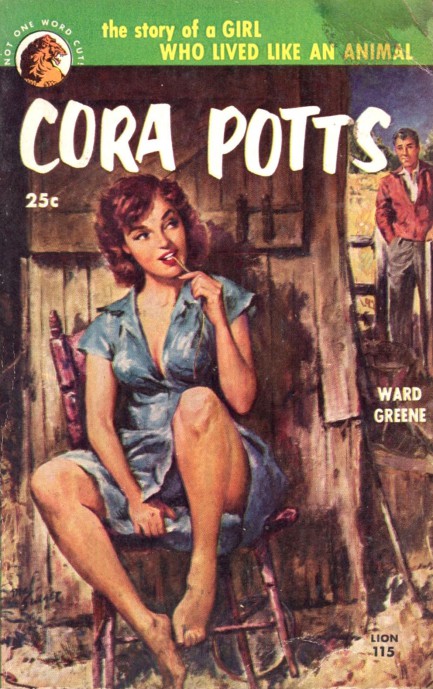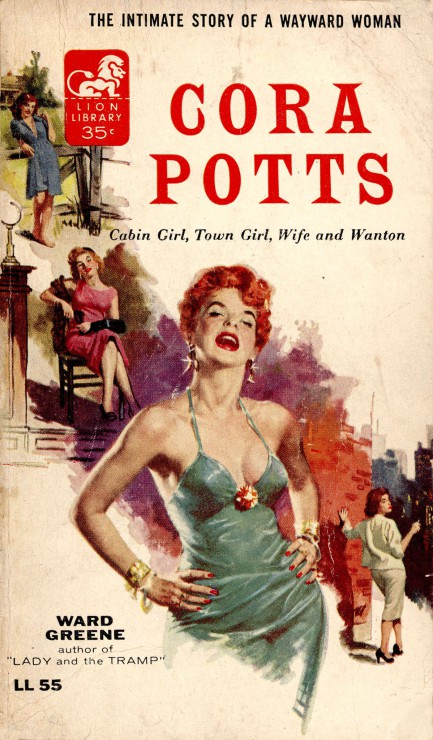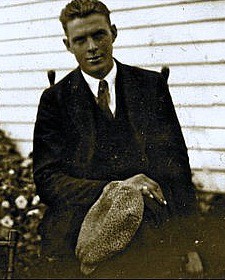
I can’t wait until I can afford a good pair of high heels—then when I walk all over these chumps it’ll actually hurt them.

Above is the cover for the 1952 Lion Library paperback edition of Ward Greene’s Cora Potts, which was originally published in 1929 as Cora Potts: A Pilgrim’s Progress. An illiterate country girl robs her father’s store, runs away barefooted to the big city, eventually commits murder, and ends up a respectable, nouveau riche society wife. Greene was saying that the U.S. was a country that rewarded greed and ruthlessness, while respect for the rules was peddled to the lower classes to keep them in line. Some critics found this formulation unpalatable, and many thought the part where Potts burns through $100,000 in one year was just impossible. As that’s only about $1.3 million in today’s money we find their protests bizarre, but in any case Greene had based his character on an actual femme fatale with the amazing name of Kitty Queen.
Catherine Queen, as she had been born, indeed progressed from barefoot Georgia bumpkin to bejeweled society dame. She became public knowledge briefly in 1929 when her dupe of a husband, a prominent banker, was nabbed for embezzlement and the facts of his lavish expenditures on Queen came out at trial. How much had he spent on her in a year? $147,000. And like Cora Potts’ hapless first husband, Queen’s husband still loved her, wrote heartrending letters from prison, and sent her the few meager dollars he still collected via various means. And yet Queen never visited him once, same as Potts never visits her imprisoned spouse. The Manhattan critics who doubted the novel's verisimilitude knew nothing about Kitty Queen, but Greene had lived and worked in Atlanta and down there her story had been big news.

 The cover at top is by Mal Singer, and the art from Lion’s 1955 re-issue at right was painted by Robert Maguire. Greene’s book is surprisingly obscure today, but its general message that in a corrupt society vice is virtue resonates more than ever. His genius was also in having a female character behave in a way typically ascribed to successful men, and having her go unpunished for breaking both the rule of law and of gender. Greene touched on similar themes more than once, but also wrote upbeat material. One of those pieces was a short story called, “Happy Dan, the Whistling Dog,” which appeared in Cosmopolitan and became a primary inspiration for one of the most beloved screen romances of all time—the animated feature Lady and the Tramp.
The cover at top is by Mal Singer, and the art from Lion’s 1955 re-issue at right was painted by Robert Maguire. Greene’s book is surprisingly obscure today, but its general message that in a corrupt society vice is virtue resonates more than ever. His genius was also in having a female character behave in a way typically ascribed to successful men, and having her go unpunished for breaking both the rule of law and of gender. Greene touched on similar themes more than once, but also wrote upbeat material. One of those pieces was a short story called, “Happy Dan, the Whistling Dog,” which appeared in Cosmopolitan and became a primary inspiration for one of the most beloved screen romances of all time—the animated feature Lady and the Tramp.
And just to dig as deeply into this subject as we can, there is some confusion online about when Greene wrote that dog story. Nearly every website says 1943, but then again nearly every website copies from other websites. A couple of sources say the story is from 1924, while a French page says 1937. We don’t know when he wrote it, but we’re inclined to believe the 1924 date. Greene was already in his mid-thirties by then, and had been writing for Cosmo since at least 1923, publishing a piece on F. Scott Fitzgerald that year. We think Walt Disney probably read the Happy Dan story in 1943 in an old Cosmo, and at that point contacted the now respected literary figure Greene about buying the property and adapting it. But we don’t know for sure. Someone in the real world of actual libraries with actual paper info will have to sort this one out.



 The cover at top is by Mal Singer, and the art from Lion’s 1955 re-issue at right was painted by Robert Maguire. Greene’s book is surprisingly obscure today, but its general message that in a corrupt society vice is virtue resonates more than ever. His genius was also in having a female character behave in a way typically ascribed to successful men, and having her go unpunished for breaking both the rule of law and of gender. Greene touched on similar themes more than once, but also wrote upbeat material. One of those pieces was a short story called, “Happy Dan, the Whistling Dog,” which appeared in Cosmopolitan and became a primary inspiration for one of the most beloved screen romances of all time—the animated feature Lady and the Tramp.
The cover at top is by Mal Singer, and the art from Lion’s 1955 re-issue at right was painted by Robert Maguire. Greene’s book is surprisingly obscure today, but its general message that in a corrupt society vice is virtue resonates more than ever. His genius was also in having a female character behave in a way typically ascribed to successful men, and having her go unpunished for breaking both the rule of law and of gender. Greene touched on similar themes more than once, but also wrote upbeat material. One of those pieces was a short story called, “Happy Dan, the Whistling Dog,” which appeared in Cosmopolitan and became a primary inspiration for one of the most beloved screen romances of all time—the animated feature Lady and the Tramp.



































































